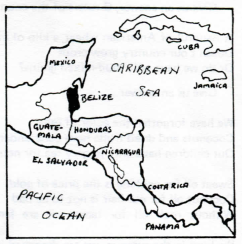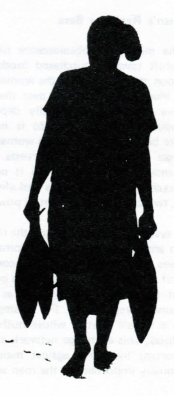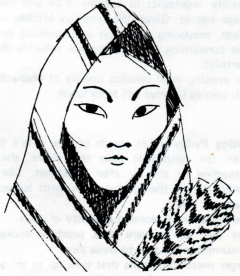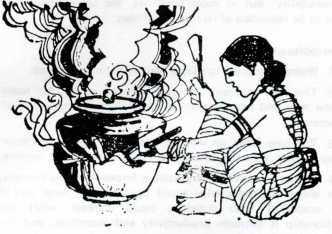women agriculture and development in the maya lowlands: profit or progress
OLGA STAVRAKIS
MARION LOUISE MARSHALL
Introduction
In has often been argued that the standard type of "development" based upon the production of export crops has benefited only the very few able to exploit the new opportunities but not society as a whole. More recently it has become apparent that while men benefit from agricultural modernization women may actually lose and the growing child may pay the price (1).
Our research, carried out in a small community in Central America, documents in some detail the actual process of change which took place with the development of the sugarcane industry. A connection is made between the rapid rise of sugarcane production in 1973 and three other factors: the decline of food production, the loss of female resource base, and the lack of improvement in child nutrition. It is suggested that the present situation is a result of a number of factors which dictate " profit not progress".
The Village
The village which we studied lies in the sugarcane district of northern Belize, a self-governing British Protectorate, on the coast of the Yucatan Peninsula in Central America. The village will be referred to as Rio Hondo. The country is inhabited by a mixed population of some 137,000 people of Maya Indian, Afro - Caribbean , East Indian, and European origins. There are approximately 300 inhabitants of Maya/ Spanish origin in the village which is located in what is generally called the Maya lowlands. The area is cultivated by small groups of slash and burn farmers who plant corn as their staple crop.
The Problem
From all standard economic indicators it appears that the northern area of Belize is developing rapidly. Between 1973 and 1974 the income in a few families in Rio Hondo rose astronomically, perhaps jumping from US $ 1,000 a year to as much as U S $ 13,000. For the rest, the very poor farmers who may have made only US $ 300/ year, income doubled or tripled by working for the more affluent. During this time some families began to plant sugarcane because the price was good and climbing. The more affluent farmers in the district who owned their own land and had collateral for loans rushed into sugarcane first. But the more traditional farmers did not jump into cane so rapidly either from preference or an inability to do so. Unfortunately, however, due to sugarcane expansion most of their fallow land became appropriated for the cash crop . Although these traditional families did not wish to work as labor, the males were forced to seek temporary jobs just to break even as prices soared (2)
After the lucrative 1973 season the number of small sugarcane farmers grew by leaps and bounds. Second hand trucks, tractors, pickups, and large fourteen-ton haulers began to appear everywhere in the District and money seemed to pour into men's hands. This was prosperity, but prosperity at a price, and then only for a few! For money flowed out of the system as fast as it came in, spent on drink, trucks, travel and purchased female companionship. By and large it did not benefit the women at home tending the children and animals. Thus, it did not have any effect on the already marginal diet of small children which remained unchanged during and after the cane boom. Those families which decided to stay with the old values and produce food crops became the poor in a society which redefined what was rich and what was poor.
.Yet, while money flowed freely in the north, food was seriously short both there and throughout the country as the production of food crops had gone down. Most important, a series of new social tensions and frustrations developed within and between families formerly accustomed to cooperating. This took place in spite of the fact that the GDP of the country had doubled between 1973 and 1976. Why? We will try to describe the changes taking place and analyze them in the context of the cultural process.
The Decline of Food Production
Prior to the tremendous increase in cash cropping, several food procurement systems were utilized. There were the slash-and-burn plot (milpa), the kitchen garden, hunting and gathering, animal husbandry, and fishing. Labor was strictly divided between males and females, the males operating with in the domain of the forest, practicing milpa agriculture and hunting and gathering. The females cared for kitchen gardens and dooryard animals. These different food procurement systems complemented each other and provided all the needed foods. They were regulated by strictly defined social obligations which maintained cooperation and stability . Some cash was also needed, however, for clothes, medical care, and increasingly for those things which ceased to be produced locally. Men made some cash by occasional labor but women depended upon food production for cash, either selling some of their garden produce or feeding their dooryard animals and selling the meat (3).
Each adult woman customarily tended a kitchen garden,an area 1/4 to 1/2 an acre beside her house. Fruits , vegetables, nuts, seeds, herbs, greens, tubers, and utilitarian an household materials could be harvested year round from this garden. Up to 40 species of plants have been found in any one garden. This type of technology represented an intricate and well adapted system which maintained high fertility and land productivity under tropical conditions by manipulating the competitive and complementary attributes of plants (4).
The women also cared for a large variety of door yard animals. Pigs fed on kitchen scraps as well as corn and other products from the milpa which might otherwise have spoiled, provided women with a much needed source of cash. Each woman usually kept four or five pigs: a couple of castrated males for food and/or money, an older breeding female to give young, and one or two younger pigs to butcher on special occasions. Depending upon the food supply and hence the growth rate of the animal, it could reach 150 lbs., with in a year, bringing in up to US $ 48.00 (in 1973). Each woman also had two or three dozen chickens and laying hens exclusively for household consumption. Most women raised turkeys for special occasions, and a few ducks, pigeons, and/or geese. These also were fed a combination of maize and table scraps (5).
Men customarily produced field crops through slash-and burn agriculture. A plot of high forest in the jungle was felled with a machete. The bush was left to dry after which it was burned. After the first rains came, it was planted with corn and inter cropped with numerous other plants.Two consecutive years of planting were possible before yields started to go down rapidly due to nutrient loss and weeds at which time a new plot was sought. The old plot remained in fallow , ideally for 10 to 12 years, to replenish all the soil nutrients ( 6 ).
Although food production began to decline a number of years ago, this decline was speeded by the rapid acceptance of sugarcane. Sugarcane not only created a land shortage but also it hastened the cultural devaluation of local foods and local agriculture practices. In 1973 the standard fallow cycle was still 6 to 8 years and in 1976 it had been reduced to 2 or 3 because much of the fallow land was taken up for sugarcane. Shortening the fallow period without appropriate intensification led to progressive deterioration of the soil and diminishing yields.
With a 12 year fallow cycle, expected yields in Rio Hondo were 2,500 lbs/acre of corn plus the inter cropped beans, cassava, tomatoes, Xanthosoma, squash, and others. When the fallow cycle was reduced to 4 years, the expected corn yields went down dramatically, and with the decreased time investment the inter crops were reduced. Between 1973 and 1976 a good yield was considered 900 lbs/acre and few males actually harvested that much (7).
Customarily, 25-40% of the corn yield was fed to pigs and chickens by the women. This represented that part of the harvest which was spoiled or blighted. Therefore, the reduction in milpa yield had immediate consequences for women.
Although planting milpas of approximately the same size as before, many men now prefer to invest less time and effort in their care. Whereas in the past prestige for a man was tied to good milpa production , with the coming in of western values and the creation of new wants and needs, a prestige system based upon western material goods penetrated the society. Since the villagers did not possess these goods and, in the past, had no means by which to acquire them, by definition , they were " inferior " . When the opportunity to acquire goods came by way of sugarcane, it came only for the males. No such opportunity offered itself to the women. At the same time, traditional methods of production, local crops, and local foods became identified with the " inferior" past (8).
Changes in production go hand in hand with changes in consumption. As the local foods lost their prestige value, women's gardens became obsolete. The actual changes in consumption we documented between 1973 and 1974 indicate that consumption of local fruits had declined by 3 4% in spite of the fact that trees were still in the gardens, still bearing fruit . The consumption of meats and fish also declined but the percent of canned meat in the sample went up from 137o to 19% . Consumption of soft drinks and frozen koolaid increased by 255% and intake of cookies and sweet prepared foods increased by 2 5 % . In 1974 total consumption of corn, beans, rice and wheat increased by 1 9 % . The greatest increase was in wheat consumption which represents a significant shift in food preferences as wheat had gone up in price between 1973 and 1974 more than had maize. In 1974 rice was almost unavailable for part of the year and the price had risen sharply. Neither rice nor kidney beans, which had in the very recent past been produced locally, were grown within the community.
These changes in production and consumption had repercussions upon the social organization of the household and the community. The greatest effect of these changes was felt by the women whose food production alternatives had suddenly radically decreased (9).
The Loss of Women's Resource Base
The decline of the milpa, the obsolescence of the kitchen garden and the shift towards purchased foods have had a negative impact upon the activities of the women. As a result, women have lost much of the control over their productive resources and have become economically dependent upon males. Food production in Rio Hondo is no longer the cooperative venture between a man and a woman it once was. Most men no longer bring home their harvests. Some simply do not produce enough while others sell it outright. Thus there is little to exchange with relatives and almost none for pigs and chickens, two areas in which female power was based.
In the traditional system the produce from the milpa, brought home by the man and turned over to the woman for storage and distribution was basic to her social and economic power. A certain portion of the harvest would be given out to relatives in return for past favors and gifts of food as an insurance policy against future harvest failure. For example, a sack of corn might go to a female relative whose husband failed to produce enough food. This exchange network among women provided an important insurance against male failure and therefore it was equally important to the men who depended upon these reciprocal obligations in times of "bad luck" with their milpas.
Making use of the 25- 40% of the harvest which was spoiled or blighted and, thus, unfit for human consumption, women fed their pigs. Plenty of corn meant women could raise sufficient pigs for their economic and nutritional needs and those of their children. In Rio Hondo as in the rest of Belize, pigs belong to women and are the main independent source of food and money which can be measured and documented. The changing emphasis on cane production has seriously endangered women's village pig production because corn is now becoming a scarcer commodity...
Pigs are crucial to the reciprocal food exchanges operating in the village. Women regularly send live young pigs or hunks of pork to friends and relatives in Rio Hondo. These exchanges regulate the supply of meat, whilst cementing ties and relationships. In addition, pigs are the foundation of feasts, often being set aside for a special occasion from the day they are born (10).
Women maintain this resource at little energy cost to themselves. Pigs fed on table scraps and spoiled corn and that forage for themselves to supplement their diet, take little time and money to raise. Women do not manipulate their herds and, in general, practice a kind of benign neglect where their pigs are concerned. The pigs themselves serve a useful function in cleaning up garbage and converting it into food for the table.
Unfortunately pig numbers showed a considerable decline between 1973 and 1974, when village herds dropped by approximately 50 %, partly due to hog cholera, a cyclical disease. There were about 250 pigs in Rio Hondo in 1973. By 1974 this number had dropped to little over 100. Of the 28 households raising pigs in 1973 only 17 were doing so in 1974. This local decline was reflected in the national level; the number of pigs slaughtered in 1973 in Belize was 9,439. This number sank to 5,795 in 1974, roughly a 50 % decrease. Significantly, although there were shortages throughout the country, more than 2,000 hogs were exported in 1974 (11)...
Because food production has always been woven socially and ideologically into the culture, the change in production patterns has ramifications throughout society. One of the most significant has been the removal of the source of male prestige from the domestic household activities of producing good food and good children and the creation of a new "public" sphere of activity which is western and modern in nature, characterized by material goods. The women's activities are relegated almost totally to the domestic sphere, whereas the acquisition of prestige and status, once accessible to both men and women, is now largely relegated to the public sphere where women cannot compete. For women, household tasks bestowed status in the domestic arena and the community, giving them power to control their environment. As the public sphere became more "important" in Rio Hondo, due to the money and prestige acquired through cane growing, it began to dwarf the domestic sphere. The women were left with domestic activities of devalued social status and responsibility (12)...
Child Malnutrition
In spite of economic activity, greater spending on food, higher income, higher GDP, child nutrition still remains marginally low, indicating stress in t he system. Since the nutritional status of a community is the result of the interaction of a number of cultural , biological, and economic factors, and since it can be quantified , it serves as a good measure of social progress. A nutrition survey was carried out in Rio Hondo in 1973 and repeated in 1974 on a sample of 59 individuals in eight households, the same individuals being surveyed both years...
From this study several conclusions can be drawn. First, in all the families the smallest children ate the least well, and no children in the sample ate very well ..
In all cases the men ate well. If food was limited that day, the children and t he mother went without , the man still got his share. The women and children are no longer as significant in the social sense as they were before. The male's status comes from his activities in the public sphere, playing with trucks and tractors , away from home, and not from raising his children with the woman. In the richer families there is a deemphasis of the child's role. In the poorer families, which make up the majority of the 42 households, the average income did not rise substantially, thereby increasing stress and Trustration as men could not reach desired prestige goals. In response, they began to drink much more.
In early 1977 the local" cantina " (bar) was selling 48 fifths of rum a week and 14 cases of beer to service a population of approximately 60 men and youths of whom perhaps 20 were regular and occasionally heavy drinkers. In 1973, there was n o beer in Rio Hondo and only half as much rum was consumed. Of course much of the heavy drinking was and still is carried out in the local town , so this figure represents only aportion, and probably a smaller one at that, of all the consumption. For example, one male, aged 68, who was included in our nutrition survey, had consumed a fifth of rum in town during the morning of the survey. He did this regularly at least once or twice a week. Meanwhile his children were poorly fed and cared for .
The nutritional status of the children reflects the powerlessness of women with respect to the acquisition of desired foods. The traditional foods, at the same time, still available in limited quantities and potentially available in greater quantities are not perceived as resources because they are " inferior " . What mother wishes to feed her child a food she knows is inferior?
(Excerpted from the Proceedings and Papers of the International Conference on Women and Food held at the University of Arizona, Tucson, Arizona, USA in January 1978)
Bibliography and References
1. United Nations Development Programme, Guidelines on the Integration of Women in Development. Program Policy and Evaluation Division. Headquarters, N.Y., Mimeograph G 3100-1, 25 February 1977; Ester Boserup, Women's Role in Economic Development, N .Y ., S t . Martins Press, 1970.
2. United States Foreign Service, Foreign Economic Trends and Their Implications for the United States. Belize. U.S. Dept. of Commerce, Annual Reports 1976 and 1977.
3. Mary Pohl, Hunting in the Maya Village of San Antonio Rio Hondo, Orange Walk District, Belize. Journal of Belizean Affairs. Special Issue, Sept. 1977; Charles Wisdom, The Chorti Indians of Guatemala, University of Chicago Press 1940; Alfonso Villa Rojas, The Maya of Yucatan, in the Handbook of Middle American Indians, Vol 7, part 1, pp. 244-275, R. Wauchope, ed., 1969; Angel Palerm, Agricultural Systems and Food Patterns, in Handbook of Middle American Indians Vol 6. i bid . . 1967.
4 . Edgar Anderson, Plants, Man and Life, University of Cal. Press, Berkeley, 1969; Robert Wauchope, Modern Maya Houses; A Study of their Archeological Significance. Carnegie Institution of Washington, Pub. 502, 1938; Olga Stavrakis, Ancient Maya Agriculture and Future Development, Culture and Agriculture, Bulletin of the Anthropological Study Group on Agrarian Systems, A m . Anthropological Association, No.5, 1978.
5. Marion Marshall, A Pig is a Gold Tooth, Summa Thesis, University of Minnesota, College of Liberal Arts, Dept. of Anthropology, Minneapolis, 1976.
6. William E. Carter, New Lands and Old Traditions: Kekchi Cultivators in the Guatemalan Lowlands, Lat. Am . Monog. Center for Latin American Studies, University of Florida, Gainesville, 1969; Ruben Reina, Milpas and Milperos. American Anthropologist, Vol. 69 pp.1-20,1967; Michael Nelson, The Development of Tropical Lands, Johns Hopkins University Press, Baltimore, 1973.
7. D.E. Dumond, Swidden Agriculture and the Rise of Maya Civilization, Southwestern Journal of Anthropology, Vol. 17, pp. 301- 313, 1961; Dumond discusses the productivity under different forms of swidden in the Maya Lowlands and suggests that it could have been productive enough to support very dense interior populations and even civilization in the Yucatan ) Peninsula.
8. Irene Tinker, Development and t he Disintegration of the Family, Les Carnets de I'enfance, UNICEF, Vol 36, pp. 29-37; see also Boserup, op. cit.
9. Leith Mullings, Women and Economic Change in Africa, in Women in Africa, Hafkin and Bay, eds. Stanford University Press, Stanford, Cal., 1976; Michelle Zimbalist Rosaldo, Women, Culture and Society: A Theoretical Overview, in Women, Culture, and Society, Rosaldo and Lamphere, Eds. Stanford University Press, Stanford, Cal., 1974, Karen Sacks, Engels Revisited: Women, the Organization of Production and Private Property, in Woman, Culture and Society, ibid.
10. See Ruben Reina, Milpas and Milperos, op. c/r.
11 . Ministry of Finance and Economic Planning, £co/7om/c Survey - Belize, Central Planning Unit, Government of Belize, 1974.
12. Rosaldo, op. c/f.


